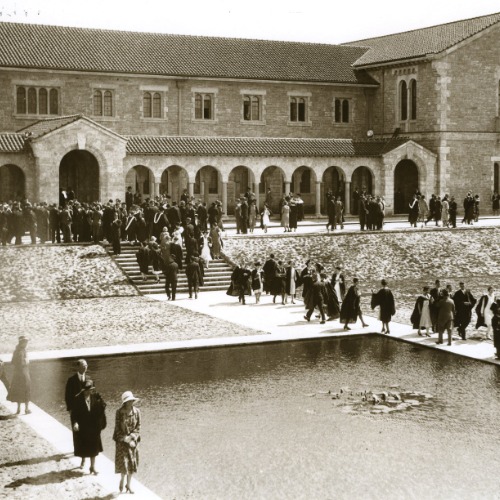Fish and fowl? It's all Greek to me
The creation of a Coat of Arms for the first free University in the Commonwealth was a serious business. The motto, images and meaning needed to set exactly the right tone. However, it took us a little while to get there.
The University Archives hold an early outline drawing of a crest but the creator and date have not been established. The first formally recognized Coat of Arms was designed by Rodney Alsop and Wilson Dobbs in 1928. At this stage, the image of the books contained only illegible lines and the swan, at least according to the then Vice Chancellor Professor Whitfeld, could have stood some improvement.
In 1929 Professor Whitfeld arranged for George Kruger Gray to design a better version. The task was to retain the motto “Seek Wisdom” but improve the design of the swan. George Gray replaced the illegible lines on the book with a collection of Greek letters and used the centenary swan in his proposed design. However, Whitfeld returned the sketches to Gray explaining, “we like the fire and emery of this bird very much. The only criticism which I have heard is that the drop in the belly is somewhat reminiscent of a fat goose”. So the fat goose had an immediate but painless banishment into obscurity.
In 1963, Gordon Stephenson was asked to redesign the crest for the Golden Jubilee. The major addition to the design was the inclusion of two hake fish on top of the lamp of learning. Sir John Hackett (son of Sir Winthrop Hackett) suggested that the hake fish would be suitable symbol to represent the family, the hake being a (rather subtle) pun on the name of Hackett.
Stephenson also replaced Gray’s Greek letters, which had caused some argument between scholars over their translation, with Latin phrases. The book on the right represented the sciences, “Nature is only mastered by obedience to her laws” and the book on the left represented the arts, “the literature that makes man more civilized and humane.” It was this design that was registered with the College of Arms in London in 1972. Interestingly, the Letters Patent registering the Coat of Arms was only recently rediscovered after being misplaced for many years. It now hangs in the University Archives office.
There have been slight changes from that day to this and today our Coat of Arms is synonymous with world-class education and Nobel prize-winning research. However, it is worth remembering that its origins contained untranslatable Greek letters, a fat fowl and a dubious fish pun.


















